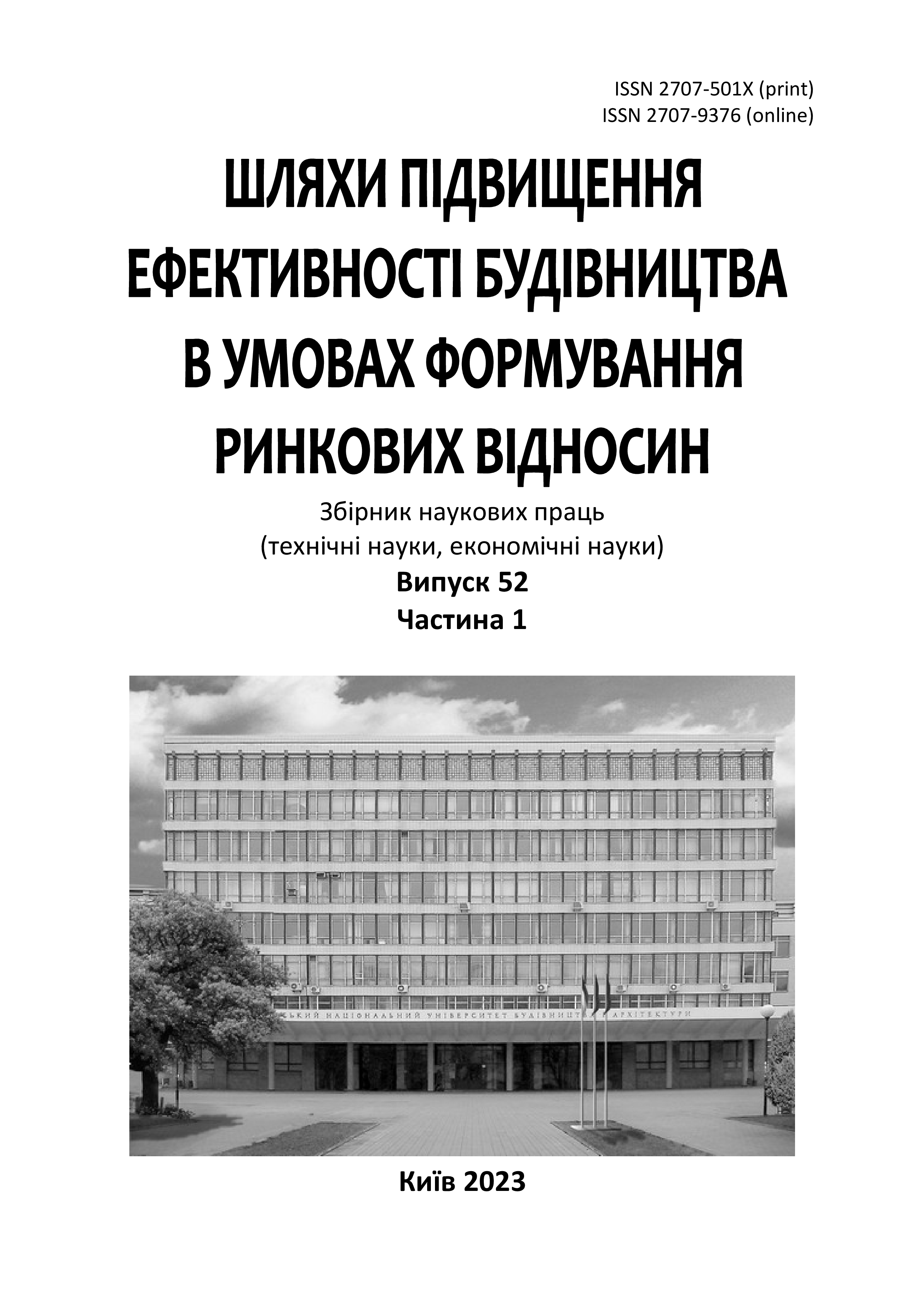SWOT-analysis of digital maturity of construction participants
DOI:
https://doi.org/10.32347/2707-501x.2023.52(1).227-237Keywords:
digitalization, innovation, enterprise, construction sector, digital transformation, digital maturity, investment construction project, competitiveness, competitive advantages, SWOT analysis, building information modeling (BIM)Abstract
The article is devoted to a comprehensive SWOT analysis of the digital maturity of construction participants. The application of the SWOT methodology, which covers strengths, weaknesses, opportunities and threats, is also relevant to developers, contractors and designers, shedding light on the complex dynamics in each group of participants, after the construction industry experiences a profound digital transformation,
The article reveals the strengths of development companies that have begun the process of digital transformation, emphasizing innovative project visualization and financial modeling. The used digital tools enable the developer to make an informed decision, optimizing the evaluation of project invalidity. However, the assessment also acknowledges some weaknesses, such as the limited adoption of Building Information Modeling (BIM), underlining the importance of overcoming the backlog of change to fully utilize digital methodologies.
For contractors, the article recognizes their strengths in digital project management and on-site technology integration that improves efficiency and real-time monitoring. However, it highlights the weaknesses of limited BIM integration and skills gaps among the workforce, creating challenges for seamless collaboration and optimal use of tools.
The article highlights the strengths of projects in the adoption of design parameters by Ukrainian project organizations and promotion of digital cooperation. However, this does not address current weaknesses such as interoperability issues and skills gaps in sustainable design, emphasizing the need for streamlined workflows and ongoing skills development.
The article also talks about ways of growth and possibilities of digitalization for each group of construction participants. Developers are encouraged to invest in data-driven decision making and a collaborative platform, while Contractors are encouraged to explore advanced construction technologies and prioritize a collaborative platform. Designers are offered opportunities for virtual design and construction (VDC) and the integration of Internet of Things (IoT) devices into their design processes, promoting innovation and efficiency. The article also examines existing challenges that construction participants may face. Developers may face threats related to unfair competition and data security issues. Contractors must overcome threats related to competitive pressures and project support, while designers may face challenges such as competitive disadvantage and resistance to Building Information Modeling (BIM) methodologies.
References
Möller, D.P.F. Cybersecurity Maturity Models and SWOT Analysis. In: Guide to Cybersecurity in Digital Transformation. Advances in Information Security, 2023. vol 103 . Springer, Cham. https://doi.org/10.1007/978-3-031-26845-8_7
Joblot L., Paviot T., Deneux D., Lamouri S. Building Information Maturity Model specific to the renovation sector. Automation in Construction. Volume 101, 2019, P. 140-159, https://doi.org/10.1016/j.autcon.2019.01.019.
КіщенкоТ.Є., Гусарова Л.В. Особливості девелопменту в реалізації інвестиційних проектів будівництва об’єктів різного функціонального призначення. Шляхи підвищення ефективності будівництва в умовах формування ринкових відносин, 2018. Вип.36, економічний. С..22 – 26.
Peng, L., Park, Y.-N., Yoo, M.-Y., Ham, N.-H., & Kim, J.-J. A Study on Chinese Smart Construction Strategy by SWOT Analysis. Journal of KIBIM, 2018. 8(4), 1–12.
Рогожин П.С., Гойко А.Ф. Економіка будівельних організацій. К.: Видавничий дім "Скарби", 2001. 448 с.
Lemieux, V.L. Blockchain recordkeeping: A SWOT analysis. Information Management, 2017. 51(6), 20–27.
Ізмайлова К.В..Урахування класу енергоефективності житлової будівлі у параметричному ціноутворенні. Шляхи підвищення ефективності будівництва в умовах формування ринкових відносин. 2019. №42. С. 19 – 25
China Construction Informatization Development Report Compilation Team. (2019). Report on the informatization development of China’s AEC industry. Beijing: China electric power press.
Конкурентоспроможність будівельної організації – основа виживання економіки: монографія / Савенко В.І. та ін.. Київ: ЦУЛ, 2017. 128 с.
Lu, W., Li, H., Shen, L., & Huang, T. Strengths, weaknesses, opportunities, and threats analysis of Chinese construction companies in the global market. Journal of Management in Engineering, 2009. 25(4), 166–176.
Сорокіна Л.В., Гойко А.Ф., Коваленко Є.С. Діагностика ефективності використання виробничих факторів у будівництві засобами канонічного аналізу. Будівельне виробництво. 2019. №66 С. 22 – 29
Федоренко В.Г., Гойко А.Ф. Інвестознавство: підручник / наук.ред. В.Г. Федоренко; Міжрегіональна Академія управління персоналом (МАУП). К.: МАУП, 2004. 408 с.
Khan A, Sepasgozar S, Liu T, Yu R. Integration of BIM and Immersive Technologies for AEC: A Scientometric-SWOT Analysis and Critical Content Review. Buildings. 2021; 11(3):126. https://doi.org/10.3390/buildings11030126
Економічне управління інноваціями : монографія / В.Г. Федоренко та ін. ; за ред. В.Г. Федоренка; КНУБА та ін. Київ : ДКС Центр, 2020. 371 с.
Цифра Т.Ю. BIM як інструмент реформування системи ціноутворення (на прикладі дорожньо-будівельних підприємств Казахстану). Шляхи підвищення ефективності будівництва в умовах формування ринкових відносин. 2021. № 47 (2). С. 168–180.
Бєлєнкова О.Ю. Стратегія та механізми забезпечення конкурентоспроможності будівельних підприємств на основі моделі сталого розвитку: монографія. Київ: Ліра-К, 2020. 512 с.
Organizational and technological model engineering in the construction industry : monograph / P.Ye. Hryhorovskyi et. al. Lviv-Toruń: Liha - Pres, 2019. 128 p
Zeltser R.Ya., Bielienkova O.Yu., Novak Ye., Dubinin D.V. Digital Transformation of Resource Logistics and Organizational and Structural Support of Construction. Nauka i innovatsii. 2019. V. 15 (5). Р. 38–51.
Титок В., Распутний Д. Імперативи управління розвитком підприємств в умовах цифровізації економіки. Цифрова економіка та економічна безпека, 2023. № 7 (07), 75-79. https://doi.org/10.32782/dees.7-12
Downloads
Published
How to Cite
Issue
Section
License

This work is licensed under a Creative Commons Attribution 4.0 International License.
Authors who publish with this journal agree to the following terms:
- Authors retain copyright and grant the journal right of first publication with the work simultaneously licensed under a Creative Commons Attribution License that allows others to share the work with an acknowledgement of the work's authorship and initial publication in this journal.
- Authors are able to enter into separate, additional contractual arrangements for the non-exclusive distribution of the journal's published version of the work (e.g., post it to an institutional repository or publish it in a book), with an acknowledgement of its initial publication in this journal.
- Authors are permitted and encouraged to post their work online (e.g., in institutional repositories or on their website) prior to and during the submission process, as it can lead to productive exchanges, as well as earlier and greater citation of published work (See The Effect of Open Access).

